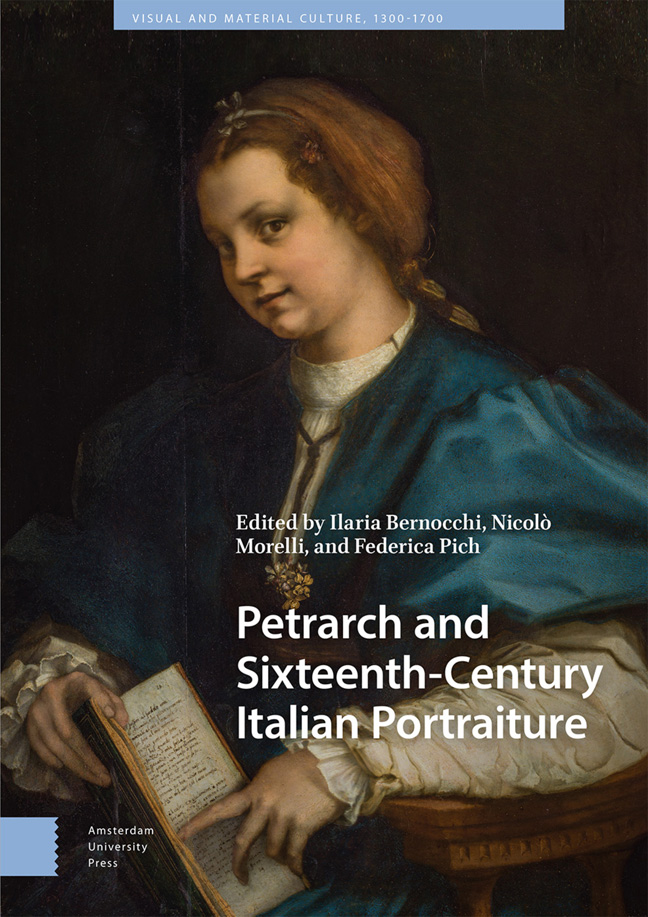Book contents
- Frontmatter
- Contents
- List of Illustrations
- Acknowledgements
- 1 Introduction
- 2 Widows, Poetry, and Portraits: Livia Spinola and Francesca Turina on the Portraits of their Dead Husbands
- 3 In Medusa's Eyes: Petrification and Marble Portraits in Late Sixteenth-Century Poetry
- 4 The Portrait of the Ideal Woman: Petrarch in Conduct Literature Texts for and about Women
- 5 Anti-Petrarchist Portraiture or a Different Petrarchist Portraiture?: A Literary Outlook on Some Non-Idealised Female Sitters in Renaissance Art
- 6 The Shadow of Petrarch: Benedetto Varchi and Agnolo Bronzino on Portraiture
- 7 Double Portraits of Petrarch and Laura in Print (c. 1544–1600)
- 8 Sonnet ‘Diptychs’ and Double Portraits: Figurative Allusions in Sixteenth-Century Encomiastic Poetry
- 9 Images of Women from Subject to Frame in Printed Portrait Books
- Bibliography
- Index
2 - Widows, Poetry, and Portraits: Livia Spinola and Francesca Turina on the Portraits of their Dead Husbands
Published online by Cambridge University Press: 22 February 2024
- Frontmatter
- Contents
- List of Illustrations
- Acknowledgements
- 1 Introduction
- 2 Widows, Poetry, and Portraits: Livia Spinola and Francesca Turina on the Portraits of their Dead Husbands
- 3 In Medusa's Eyes: Petrification and Marble Portraits in Late Sixteenth-Century Poetry
- 4 The Portrait of the Ideal Woman: Petrarch in Conduct Literature Texts for and about Women
- 5 Anti-Petrarchist Portraiture or a Different Petrarchist Portraiture?: A Literary Outlook on Some Non-Idealised Female Sitters in Renaissance Art
- 6 The Shadow of Petrarch: Benedetto Varchi and Agnolo Bronzino on Portraiture
- 7 Double Portraits of Petrarch and Laura in Print (c. 1544–1600)
- 8 Sonnet ‘Diptychs’ and Double Portraits: Figurative Allusions in Sixteenth-Century Encomiastic Poetry
- 9 Images of Women from Subject to Frame in Printed Portrait Books
- Bibliography
- Index
Summary
Abstract
This essay analyses two examples of poems dedicated to the portrait of the beloved by Livia Spinola and Francesca Turina. It begins by highlighting portraiture's function of substituting the beloved in the Petrarchist tradition and in Renaissance culture, and by considering its implications when the person portrayed is deceased. It then explores the ways in which female lyric subjects subvert the genre's implicit gender dynamics and how they negotiate their status as widows, examining the role of the portrait in their mourning process. Livia Spinola's poem frames the object-portrait as positive, capable of saving her from a near-death situation caused by excessive grief. Francesca Turina's sonnet shows quite the opposite scenario: deeply engrossed in her grieving process, the poem presents her husband's portrait as a real threat to her recovery because of its illusionary power.
Keywords: Petrarchism, women's writing, widowhood, portraits, mourning
Poetry on Portraiture and the Function of the Image
Poetry on portraiture constitutes a major intersection between the visual arts and the written word in the Italian Renaissance. This genre brought together word and image, promoting not only competition but mutual reflection; it also provided an opportunity for cultural and sentimental correspondence in verse within a landscape in which Petrarchism had progressively become a form of self-definition and communication, not just a poetic language. A favourite subject was, of course, the portrait of the poet's beloved, inspired by Petrarch's Rvf 77 and 78, the sonnets dedicated to the portrait of Laura painted by Simone Martini. These sonnets are among the first—and probably most influential—examples in the vernacular tradition of lyric poetry engaging with an external (and material) image; they initiated a genre that came to be widely practised in the Renaissance.
Across the whole genre, however, female voices seem to be, if not entirely absent, certainly very rare. Although literature by female authors was, by and large, favourably received in the sixteenth century, there are very few poems on portraits attributed to women, particularly on the subject of the portrait of the beloved. This raises some interesting questions about the suitability of the genre for the emerging female voices in the Renaissance period.
- Type
- Chapter
- Information
- Petrarch and Sixteenth-Century Italian Portraiture , pp. 43 - 62Publisher: Amsterdam University PressPrint publication year: 2023



